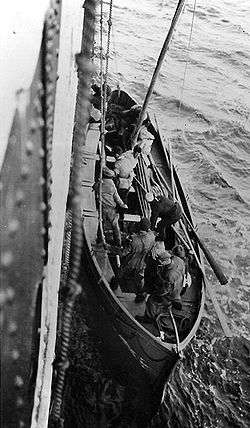Action of 18 June 1918
| ||||||||||||||||||||||||||||||
The Action of 18 June 1918 was an attack on two allied ships near Bermuda in the Atlantic Ocean by an Imperial German Navy u-boat during World War I. Sinking an allied merchant vessel, the U-boat failed to destroy an American warship which came to the merchantman's aid.
Action
The SS Dwinsk was a British flagged merchant ship known for her involvement in the War at Sea. On 18 June 1918, while steaming in the Atlantic from France to Newport News, Virginia, Dwinsk encountered the German submarine U-151 around 400 mi (350 nmi; 640 km) from Bermuda.
The submarine surfaced and fired a torpedo into the helpless British steamer which caused severe damage. No distress call is known to have been sent by Dwinsk. The deaths of 22 or more British sailors have been confirmed, others were reported to have minor injuries. The dead either went down with Dwinsk when she sank or were in a lifeboat that went missing after their vessel went down. U-151's action was not over though, instead of fleeing after sinking the Dwinsk, she waited in the vicinity for any allied vessels coming to aid the British lifeboats which did not attempt to abandon the wreckage of their transport. The German U-boat remained for a few hours, using the stranded Britons as bait.

USS Von Steuben—which just happened to be returning to America from Brest, France—sighted the wreckage of Dwinsk from over five miles away. What the Americans saw were seven lifeboats that appeared to be empty. The boats appeared to be empty due to the captain of Dwinsk; he had ordered the crew to lie down to prevent allied vessels from approaching and being attacked by the Germans. Von Steuben made her approach anyway and began zig-zagging as a measure against torpedo attack.
Sure enough, as Von Steuben closed the British lifeboats, the wake of one or two torpedoes were spotted coming towards the ship off her bow from abaft the port beam. Quickly the American commander was informed of the situation and ordered his crew to battle stations. Von Steuben fired her first shells in anger at the incoming torpedo, while another turret fired on U-151's periscope which was seen at the other end of the torpedo's trail. The shots fired at the torpedo apparently missed their target but Von Steuben was able to maneuver fast enough to keep out of the torpedo's path which missed by just a few yards from the auxiliary Von Steuben. Once over the U-boat's last known position, the Americans dropped over 12 depth charges which shook the submarine severely—according to German accounts—and forced her to flee.
Aftermath
Von Steuben's crew did not rescue any of the Britons that night. It was not until later that the Americans learned that the survivors were lying down in their boats. The American commander did not want to risk his ship by slowing down to investigate the lifeboats. If Von Steuben had stopped to check the lifeboats, she would have been exposed to a torpedo attack.
Six of the seven lifeboats were rescued by other allied ships; the seventh boat with about 20 men aboard was never heard from again. USS Siboney rescued two boats on 21 June and USS Rondo picked up the final boat on 28 June. This engagement was Von Steuben's only combat action during World War I.
See also
References
- Roessler, Eberhard (1997). Die Unterseeboote der Kaiserlichen Marine. Bonn: Bernard & Graefe. ISBN 978-3-7637-5963-7.
- Halpern, Paul G. (1995). A Naval History of World War I. New York: Routledge. ISBN 978-1-85728-498-0.
- Drechsel, Edwin (1994). Norddeutscher Lloyd, Bremen, 1857–1970: History, Fleet, Ship Mails, Volume 1. Vancouver, British Columbia: Cordillera Pub. Co. p. 191. ISBN 978-1-895590-08-1. OCLC 30357825.
- Putnam, William Lowell (2001). The Kaiser's Merchant Ships in World War I. Jefferson, North Carolina: McFarland. ISBN 978-0-7864-0923-5. OCLC 46732396.
